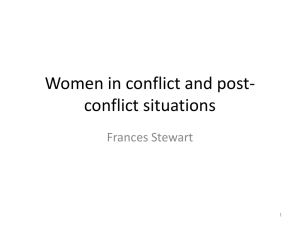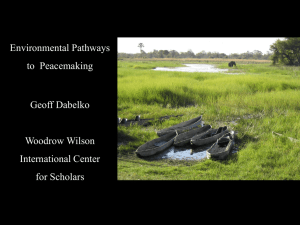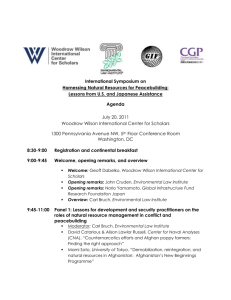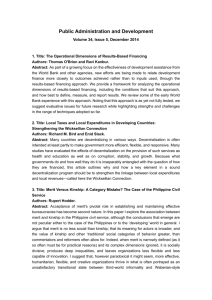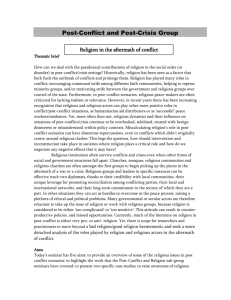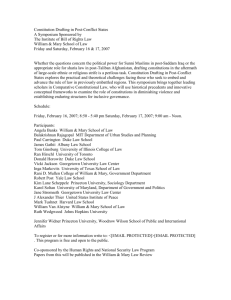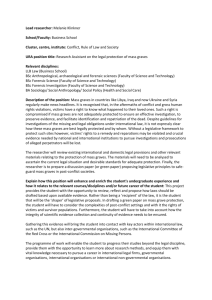CRS Report for Congress World Bank Post-Conflict Aid: Oversight Issues for Congress
advertisement
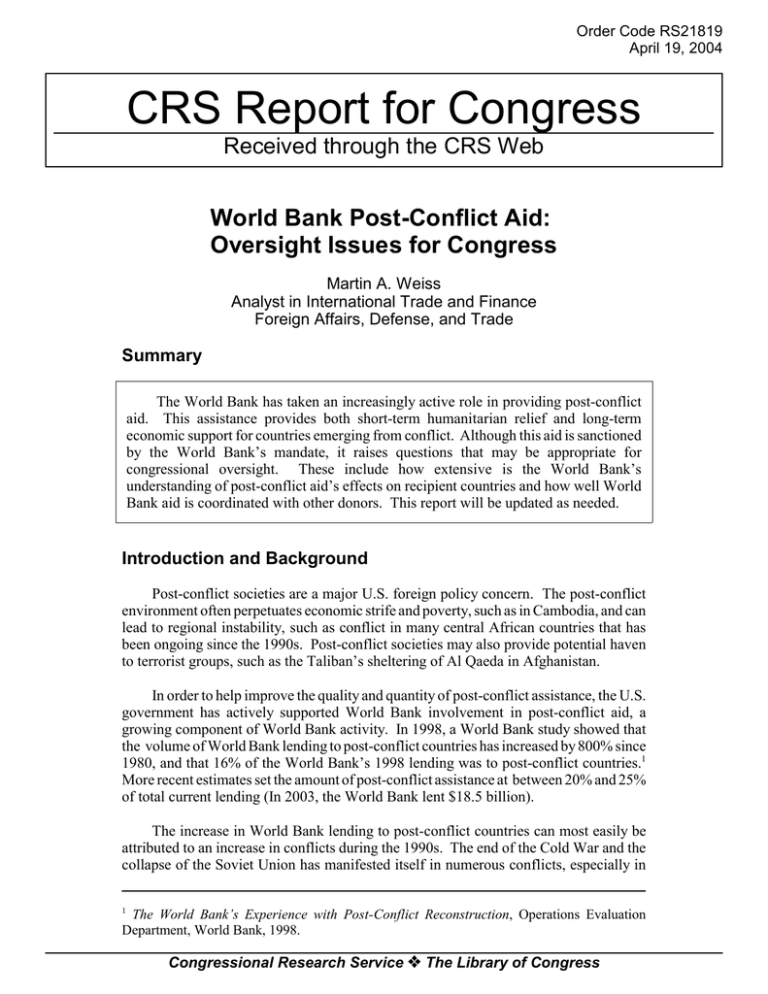
Order Code RS21819 April 19, 2004 CRS Report for Congress Received through the CRS Web World Bank Post-Conflict Aid: Oversight Issues for Congress Martin A. Weiss Analyst in International Trade and Finance Foreign Affairs, Defense, and Trade Summary The World Bank has taken an increasingly active role in providing post-conflict aid. This assistance provides both short-term humanitarian relief and long-term economic support for countries emerging from conflict. Although this aid is sanctioned by the World Bank’s mandate, it raises questions that may be appropriate for congressional oversight. These include how extensive is the World Bank’s understanding of post-conflict aid’s effects on recipient countries and how well World Bank aid is coordinated with other donors. This report will be updated as needed. Introduction and Background Post-conflict societies are a major U.S. foreign policy concern. The post-conflict environment often perpetuates economic strife and poverty, such as in Cambodia, and can lead to regional instability, such as conflict in many central African countries that has been ongoing since the 1990s. Post-conflict societies may also provide potential haven to terrorist groups, such as the Taliban’s sheltering of Al Qaeda in Afghanistan. In order to help improve the quality and quantity of post-conflict assistance, the U.S. government has actively supported World Bank involvement in post-conflict aid, a growing component of World Bank activity. In 1998, a World Bank study showed that the volume of World Bank lending to post-conflict countries has increased by 800% since 1980, and that 16% of the World Bank’s 1998 lending was to post-conflict countries.1 More recent estimates set the amount of post-conflict assistance at between 20% and 25% of total current lending (In 2003, the World Bank lent $18.5 billion). The increase in World Bank lending to post-conflict countries can most easily be attributed to an increase in conflicts during the 1990s. The end of the Cold War and the collapse of the Soviet Union has manifested itself in numerous conflicts, especially in 1 The World Bank’s Experience with Post-Conflict Reconstruction, Operations Evaluation Department, World Bank, 1998. Congressional Research Service ˜ The Library of Congress CRS-2 Africa, and poor and developing countries who were recipients of large aid flows from the Soviet Union. During the 1990s, civilian war-related deaths accounted for 90% of all war-related deaths and violence created approximately 13 million refugees and 38 million internally displaced persons world-wide.2 Congress intermittently appropriates funds to the World Bank to fund its aid programs.3 In July 2002, World Bank donor countries agreed on the thirteenth replenishment of the International Development Authority (IDA), the concessional lending facility of the World Bank.4 The new replenishment, dubbed IDA-13, authorized $22.8 billion in new aid for 2003-2005. The United States committed $2.55 billion to IDA-13 ($850 million for each year, FY2003-FY2005), in addition to $300 million pledged in incentive contributions if the World Bank meets certain performance targets. For FY2005, the President is requesting $1.05 billion for the third of three scheduled payments under IDA-13 ($850 million base payment and $200 million of the $300 million incentive pledge). In addition, the President is requesting $11.3 million to pay a portion of U.S. arrears to IDA. In FY2006, the President may also request Congress to authorize and appropriate funds for IDA-14, currently under negotiation. Defining Post-Conflict Aid Post-conflict reconstruction aid is a unique form of development assistance with two goals: (1) addressing short-term challenges which may include humanitarian assistance, and other forms of relief and post-emergency assistance; and (2) repairing (and in some cases creating) the infrastructure - both physical and institutional - necessary to support long-term economic development. While these goals of relief and development are not inherently incompatible, effectively distributing resources that balance these short and long-term goals is potentially the most difficult challenge for post-conflict aid. World Bank Post-Conflict Aid At the World Bank, nine countries are currently eligible for post-conflict assistance: Afghanistan, Angola, Burundi, Congo Republic, Democratic Republic of Congo, Ivory Coast, Eritrea, Sierra Leone, and East Timor. Operations in non-sovereign regions, such as the West Bank and Gaza or Iraq are funded out of World Bank net-income or through multi-donor trust funds. The regional development banks, such as the African Development Bank (AfDB) and the Asian Development Bank (AsDB), as well as the International Monetary Fund (IMF), are active in post-conflict assistance, and often coordinate and partner with the World Bank to provide post-conflict assistance. World Bank Policy. In 2001, the World Bank officially defined the terms of its post-conflict activity. Operational Policy 2.30 “Development Cooperation and Conflict” established a three-stage procedure for World Bank conflict-related assistance. This 2 The Economics of Civil Wars, Crime, and Violence, available online from the World Bank website, [http://www.worldbank.org/research/conflict/motivation.htm]. 3 4 See CRS Issue Brief IB96008, Multilateral Development Banks: Issues for the 108th Congress. Since IDA makes below market-rate loans, in addition to grants, its capital base needs to be replenished on a periodic basis. CRS-3 process is designed to help a country transition from conflict to the normal World Bank relationship with borrower countries. The first stage is called a Watching Brief, and involves monitoring the evolving socio-economic situation on the ground during a conflict. This allows the World Bank to begin preparations for its involvement once fighting ends. The second stage is the creation of a Needs Assessment, once the physical safety of World Bank staff can be guaranteed. The Bank, usually along with the United Nations (U.N.), will send in teams of analysts to research and prepare this report. This document presents the Bank’s analysis of a country’s reconstruction needs and estimates of their cost. It is normally prepared prior to an international donor conference, where countries may pledge funds and draw up the framework for a multi-donor trust fund. The Needs Assessment also plays a fundamental role in the third stage, the creation of a Transitional Support Strategy (TSS), a short to medium-term assistance plan that often acts as bridge between short-term recovery assistance and long-term development objectives. Once a recipient country successfully emerges from conflict and is eligible for lending, a Country Assistance Strategy (CAS) will be prepared by the World Bank. The CAS is the primary lending framework for World Bank assistance. Usually prepared every three years, the CAS identifies key areas where World Bank assistance would be most effective, and proposes lending projects to accomplish these goals. World Bank Grants. The World Bank is increasingly providing aid in the form of grants, rather than loans. Grants accounted for 17% of all IDA assistance in 2003. Under the IDA-13 agreement, post-conflict countries are eligible to receive up to 40% of their IDA allocation in grants. Negotiations for IDA-14 began in February 2004, and the Administration has stated it will seek to increase the percentage of IDA resources allocated as grants.5 Grant usage for 2004 is planned to be about 22%.6 IDA also sets aside $500 million per year for temporary increases for post-conflict country allocations. The World Bank has created a separate entity, the Post-Conflict Fund (PCF) to provide grants for physical and social reconstruction. In 2003, the PCF allocated $11.8 million through sixteen newly approved grants, and disbursed $13 million across its total portfolio. Since the PCF was established in 1997, $61.5 million has been approved for 120 separate grants, and $46.9 million has been disbursed.7 World Bank Watching Briefs and Needs Assessments are often funded by the PCF. World Bank Trust Funds. Aid recipients often are not a member of the World Bank. It might owe arrears to the Bank, or there might be no effective government for the World Bank to deal with. In these cases, trust funds, either administered solely by the World Bank, or by the World Bank in conjunction with other international institutions have coordinated and disbursed post-conflict aid. There is a rationale for bilateral donors to provide post-conflict aid through multilateral donors such as the World Bank. Since the World Bank’s charter abhors any 5 John B. Taylor, Under Secretary of The Treasury, “Remarks on the Millennium Challenge Corporation Selection Criteria,” Mar. 10, 2004. 6 Treasury International Programs: Justification for Appropriations, FY2005 Budget Request. The Department of the Treasury, 7 Post-Conflict Fund Annual Report 2003, World Bank. CRS-4 political involvement, many agree that it is a more proficient (as well as more credible) provider of information about post-conflict countries. A study has also shown that bilateral foreign aid is often heavily determined by donor foreign policy interests, rather the economic needs of the recipient country.8 Moreover, since the World Bank has some degree of autonomy from its donor members, it may be easier for the Bank to secure policy reforms in recipient countries than by individual donors. It is also argued that governments provide aid multilaterally when their publics are more skeptical about the benefits of providing the foreign aid. Sending foreign assistance through an institution such as the World Bank can also help a donor government reassure its citizens that its foreign aid (funded by tax revenue) is being spent appropriately.9 Some analysts contend that the United States loses too much control over the provision of its aid with a multilateral approach. First, they argue, it is very difficult for donors to earmark funds when they are contributed multilaterally. If other donors are not in broad support of the U.S. aid agenda, the United States might be able to achieve its foreign policy objectives more directly by providing bilateral aid through the U.S. Agency for International Development or some other U.S. agency. Second, since the United States does not have a veto power on World Bank lending, the Bank sometimes provides assistance to countries, despite strong U.S. opposition. For example, the World Bank approved $180 million in earthquake recovery in 2003 for Iran, a State Departmentdetermined supporter of international terrorism. A purely bilateral approach might ensure that no U.S. funds are used to support aid programs that run counter to U.S. foreign policy. Oversight Issues for Congress Although aid is highly context specific, some general questions may be raised as Congress exercises its oversight role and considers appropriations for the World Bank and other international financial institutions involved in post-conflict assistance. Most importantly, post-conflict operations are a major component of the current IDA-14 negotiations. These negotiations are expected to be concluded by the end of 2004, with the President seeking appropriations and authorization during the upcoming 109th Congress. How Extensive Is World Bank Research into How Aid Impacts Postconflict Countries? Some argue that the World Bank often rushes in to provide assistance during post-conflict transitions without a full understanding of the implications of how post-conflict aid affects the recipient country. Critics have noted that on some occasions, World Bank interventions could serve to recreate the political or economic conditions that led to conflict in the first place.10 Increased conflict analysis and research 8 Alesina, Alberto and Dollar, David, “Who Gives Foreign Aid to Whom and Why?” NBER Working Paper No. w6612, June 1998. 9 Milner, Helner, Why Multilateralism? Foreign Aid and Domestic Principal-Agent Problems, Feb. 12, 2004, mimeo. 10 “World Bank, IMF and Armed Conflicts: Helping Peace or Creating the Conditions for War?,” Bretton Woods Project, Feb. 2004. CRS-5 into the roots of civil violence could help to ensure that civil violence is not systemically repeated. Does the Post-Conflict Country Have the Institutional Infrastructure to Effectively Utilize Donor Assistance? Studies have found that although postconflict countries’ absorptive capacity is low during roughly the first three years after the end of violence, it tends to double by the end of the first decade.11 This research suggests that it may be best not to create an “aid surge” in the immediate years after the cessation of violence, but rather phase in assistance over the first decade. However, post-conflict countries often receive the highest levels of foreign aid early on, and such assistance often tapers off over the ensuing years. What Is the Appropriate Sequencing of Reforms? Although there is often low initial aid absorptive capacity, early policy decisions can greatly affect long-term economic growth potential. One World Bank study found that social policies, such as monitoring poverty and establishing safety nets for marginalized members of society, are very important in the immediate post-conflict environment, but that such policy choices have been insufficiently incorporated into the design of post-conflict aid. Evidence shows that donors often make monetary and fiscal policy, and debt management their first priority once they commit post-conflict aid.12 Is There a Clear and Well-Defined Objective Before Aid Is Given? Although each recipient has both short and long-term assistance needs, an aid program can only be successful if these needs are clearly defined. The Bank has been very successful in conducting needs assessment reports that have served as guides for postconflict assistance. Since many other actors are involved in the post-conflict environment (such as the U.S. Agency for International Development, U.N. Development Program, various international non-governmental organizations) a clear, well-coordinated objective is imperative for a successful transition out of conflict. How Does the World Bank Ensure That Short-term Policies Enacted Do Not Compromise Long-Term Objectives? Expansionary economic policies such as price controls or rapid expansion of government employees, may create a needed short-term economic stimulus, but they can complicate a country’s long-term economic viability. For example, immediately following the introduction of aid flows to the West Bank and Gaza, public expenditures dramatically increased along with a proliferation of government ministries.13 Once aid levels come down, it is much harder to restrain fiscal spending. Consistency among short and long-term economic policy plans is essential. Is There a Clear and Well Defined Exit Strategy? A major objective of any post-conflict assistance must be the encouragement of local capacity-building to make governing decisions and ensure that local populations are active participants in the 11 Collier, Paul and Hoeffler, Anke “Aid, Policy and Growth in Post-Conflict Societies,” World Bank Working Paper, Oct. 2002. 12 13 Ibid. Schiavo-Campo, S., “Financing And Aid Arrangements In Post-Conflict Situations,” World Bank Working Paper, May 2003, p 10. CRS-6 reconstruction process. Domestic institutions must be built that can eventually take over the reconstruction process. A recent study has shown that in some cases, countries can become recurrent users of international financial assistance. These countries often lack the incentive and ability to make necessary reforms.14 Is the World Bank’s Role Appropriately Coordinated with the United Nations and Other Donors? Since the World Bank’s mandate forbids its involvement in security and military related activities, the U.N. plays a vital and important role in establishing physical security, and often takes responsibility for many political matters outside of the World Bank’s mandate. In some cases, such as East Timor, the U.N. has served as the de facto government of the post-conflict region. In addition to providing security or its governance function, the U.N. also has an external development role in helping the World Bank coordinate donor assistance. Functional conflicts of interest could occur if the U.N. is helping coordinate the distribution of aid and at the same time is serving as de facto government and is a recipient of aid flows. How Extensive Is the Monitoring and Evaluation of Post-Conflict Aid? A major objective of the U.S. government and other donors is to reinforce the World Bank’s efforts to increase the use of measurable results and performance based allocation in the World Bank’s lending. International attention often fades as one international crises segues into the next. Because post-conflict assistance is often most valuable years after the end of violence, further monitoring and evaluation of post-conflict aid efforts may be prudent to ensure that the Bank is administering such aid effectively and adhering to U.S. policy objectives. This would also be in line with the Administration’s results measurements objectives. Additional Issues. Active World Bank post-conflict activity raises many other questions, including how do donor countries foreign policy objectives interact or interface with the World Bank’s mandate to avoid political activity? What are the lessons learned from earlier interventions and how successful have the interventions been? Is the World Bank the best international actor to coordinate development assistance? Has previous donor coordination been successful, or has there been overlap between national agencies’ activities and the other development banks? Should post-conflict aid be provided in the form of grants or loans? Definitive answers are not available for many of these questions, but a greater understanding of post-conflict aid and its impacts would likely increase its effectiveness. 14 Independent Evaluation Office of the International Monetary Fund, Evaluation of the Prolonged Use of Fund Resources, Sept. 25, 2002.
